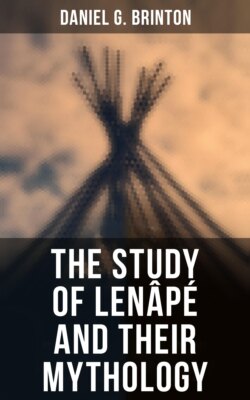Читать книгу The Study of Lenâpé and Their Mythology - Daniel G. Brinton - Страница 15
На сайте Литреса книга снята с продажи.
The Conoys.
ОглавлениеTable of Contents
The fourth member of the Wapanachki was that nation variously called in the old records Conoys, Ganawese or Canaways, the proper form of which Mr. Heckewelder states to be Canai.[27]
Considerable obscurity has rested on the early location and affiliation of this people. Mr. Heckewelder vaguely places them "at a distance on the Potomac," and supposes them to have been the Kanawhas of West Virginia.[28] This is a loose guess. They were, in fact, none other than the Piscataways of Southern Maryland, who occupied the area between Chesapeake Bay and the lower Potomac, about St. Mary's, and along the Piscataway creek and Patuxent river.
Proof of this is furnished by the speech of their venerable head chief, "Old Sack," at a conference in Philadelphia in 1743.[29] His words were: "Our forefathers came from Piscatua to an island in Potowmeck; and from thence down to Philadelphia, in old Proprietor Penn's time, to show their friendship to the Proprietor. After their return they brought down all their brothers from Potowmeck to Conejoholo, on the east side Sasquehannah, and built a town there."
This interesting identification shows that they were the people whom Captain John Smith found (1608) in numerous villages along the Patuxent and the left bank of the lower Potomac. The local names show them to have been of Algonkin stock and akin to the Nanticokes.
Conoy, Ganawese, Kanawha, are all various spellings of a derivative from an Algonkin root, meaning "it is long" (Del. guneu, long, Cree kinowaw, it is long,) and is found applied to various streams in Algonkin territory.[30]
Piscataway, or Pascatoway, as it is spelled in the early narratives, also recurs as a local name in various parts of the Northern States. It is from, the root pashk, which means to separate, to divide. Many derivatives from it are in use in the Delaware tongue. In the Cree we have the impersonal form, pakestikweyaw, or the active animate pasketiwa, in the sense of "the division or branch of a river."[31] The site of Kittamaquindi (kittamaque-ink, Great Beaver Place,) the so-called "metropolis of Pascatoe,"[32] was where Tinker's creek and Piscataway creek branch off from their common estuary, about fifteen miles south of Washington city.
The "emperor" Chitomachen, Strong Bear (chitani, strong, macha, bear), who bore the title Tayac (Nanticoke, tallak, head chief) ruled over a dominion which extended about 130 miles from east to west.
The district was thinly peopled. On the upper shores of the west side of the Chesapeake Captain John Smith and the other early explorers found scarcely any inhabitants. In 1631 Captain Henry Fleet estimated the total number of natives "in Potomack and places adjacent," at not over 5000 persons.[33] This included both sides of the river as high up as the Falls, and the shores of Chesapeake Bay.
Chitomachen, with his family, was converted to the Catholic faith in 1640, by the exertions of the Jesuit missionary, Father Andrew White, but died the year after. When the English first settled at St. Mary's, the tribe was deserting its ancient seats, through fear of the Susquehannocks, and diminished rapidly after that date.
Father White was among them from 1634 to 1642, and composed a grammar, dictionary and catechism of their tongue. Of these, the catechism is yet preserved in manuscript, in the library of the Domus Professa of the Jesuits, in Rome. It would be a great benefit to students of Algonkin dialects to have his linguistic works sought out and published. How far his knowledge of the language extended is uncertain. In a letter from one of the missionaries, dated 1642, who speaks of White, the writer adds: "The difficulty of the language is so great that none of us can yet converse with the Indians without an interpreter."[34]
That it was an Algonkin dialect, closely akin to the Nanticoke, is clear from the words and proper names preserved in the early records and locally to this day. The only word which has created doubts has been the name of "a certain imaginary spirit called Ochre."[35] It has been supposed that this was the Huron oki. But it is pure Algonkin. It is the Cree oki-sikow (être du ciel, ange, Lacombe), the Abnaki ooskoo (katini ooskoo, Bon Esprit, matsini ooskoo, Mauvais Esprit, Rasles).
It was nearly allied to that spoken in Virginia among Powhatan's subjects, as an English boy who had lived with that chieftain served as an interpreter between the settlers and the Patuxent and neighboring Indians.[36]
The Conoys were removed, before 1743, from Conejoholo to Conoy town, further up the Susquehanna, and in 1744 they joined several other fragmentary bands at Shamokin (where Sunbury, Pa., now stands). Later, they became merged with the Nanticokes.[37]
